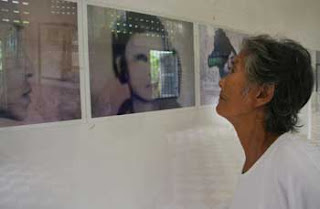

A group of young people in Tahen parish performing a dance (file photo)
(Post by Khmer HotNews Media)
BATTAMBANG, Cambodia (UCAN) -- About 90 classical dancers from all three Church jurisdictions in Cambodia gathered to take part in the first-ever Church-held seminar on the art form.
At the Sept. 23-25 seminar at Battambang parish, participants also created some new liturgical dances.
Participants came from Battambang prefecture and from Cambodia's other two Church jurisdictions -- Phnom Penh vicariate and Kompong Cham prefecture.
"The aim of this seminar is to instill in Catholic dancers a deep appreciation of classical Cambodian dance and to point out practices that are not in line with those handed down by our ancestors," said Soun Bunnarith, who heads the Battambang apostolic prefecture's cultural office.
Moreover, the seminar trained participants "on how to wear dance attire and as well as create new dances," she added.
Participants also choreographed three new dances -- the "Our Father Dance," the "Holy Spirit Dance" and a "Dance in Praise of the Virgin Mary."
Battambang vicar general Father Jose Hildy Banaynal praised participants for their creativity. The Jesuit priest stressed that the local Church is trying its best to preserve local traditions and spread the Good News through them.
Monsignor Enrique Figaredo, apostolic prefect of Battambang, agreed. "According to my 25-year experience in Cambodia, the best way to spread the Word of God and to get people to know Jesus is through culture," he said. "Classical dance, which is becoming popular here, is an important part of Cambodian culture." He also pointed out that classical dance is an effective way of spreading the word of God because the movements convey meaning.
During the seminar, Providence Sister Maria Art pointed out that the Second Vatican Council (1962-1965) encourages local Churches to inculturate the liturgy. Since the revival of the local Church in the 1990s after decades of civil war and religious persecution, it has been using Khmer language in liturgy, the nun said. "And now, we are paying attention to Cambodian dance," she added.
Several parishes in the Buddhist-majority country now run classical dance classes catering to both Catholic and Buddhist students.
At the end of the seminar, the dancers presented classical dances and songs, accompanied by traditional musical instruments.
Ron Sphear, 20, from Tahen parish, outside Battambang, said the seminar was a wonderful experience of sharing and learning from one other.
Louy Samnang, 26, from Kompot Parish in Phnom Penh apostolic vicariate, said he has learned how to use classical dance to praise God. For him, having Cambodian classical dance in the liturgy shows Catholicism is not "a European religion," as many Cambodians believe.
About 95 percent of the more than 14 million Cambodians are Buddhists. Christians form approximately 2 percent of the population.
BATTAMBANG, Cambodia (UCAN) -- About 90 classical dancers from all three Church jurisdictions in Cambodia gathered to take part in the first-ever Church-held seminar on the art form.
At the Sept. 23-25 seminar at Battambang parish, participants also created some new liturgical dances.
Participants came from Battambang prefecture and from Cambodia's other two Church jurisdictions -- Phnom Penh vicariate and Kompong Cham prefecture.
"The aim of this seminar is to instill in Catholic dancers a deep appreciation of classical Cambodian dance and to point out practices that are not in line with those handed down by our ancestors," said Soun Bunnarith, who heads the Battambang apostolic prefecture's cultural office.
Moreover, the seminar trained participants "on how to wear dance attire and as well as create new dances," she added.
Participants also choreographed three new dances -- the "Our Father Dance," the "Holy Spirit Dance" and a "Dance in Praise of the Virgin Mary."
Battambang vicar general Father Jose Hildy Banaynal praised participants for their creativity. The Jesuit priest stressed that the local Church is trying its best to preserve local traditions and spread the Good News through them.
Monsignor Enrique Figaredo, apostolic prefect of Battambang, agreed. "According to my 25-year experience in Cambodia, the best way to spread the Word of God and to get people to know Jesus is through culture," he said. "Classical dance, which is becoming popular here, is an important part of Cambodian culture." He also pointed out that classical dance is an effective way of spreading the word of God because the movements convey meaning.
During the seminar, Providence Sister Maria Art pointed out that the Second Vatican Council (1962-1965) encourages local Churches to inculturate the liturgy. Since the revival of the local Church in the 1990s after decades of civil war and religious persecution, it has been using Khmer language in liturgy, the nun said. "And now, we are paying attention to Cambodian dance," she added.
Several parishes in the Buddhist-majority country now run classical dance classes catering to both Catholic and Buddhist students.
At the end of the seminar, the dancers presented classical dances and songs, accompanied by traditional musical instruments.
Ron Sphear, 20, from Tahen parish, outside Battambang, said the seminar was a wonderful experience of sharing and learning from one other.
Louy Samnang, 26, from Kompot Parish in Phnom Penh apostolic vicariate, said he has learned how to use classical dance to praise God. For him, having Cambodian classical dance in the liturgy shows Catholicism is not "a European religion," as many Cambodians believe.
About 95 percent of the more than 14 million Cambodians are Buddhists. Christians form approximately 2 percent of the population.


























